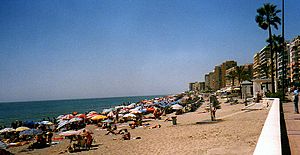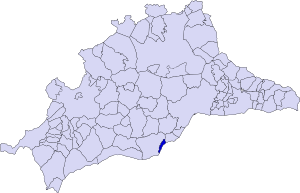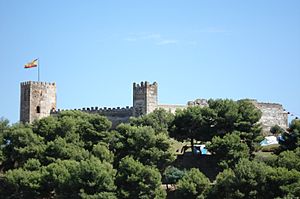Fuengirola facts for kids
Quick facts for kids
Fuengirola
|
|||
|---|---|---|---|
 |
|||
|
|||

Location of Fuengirola in Málaga province
|
|||
| Sovereign state | |||
| Autonomous community | |||
| Province | |||
| Area | |||
| • Total | 10.2 km2 (3.9 sq mi) | ||
| Elevation | 6 m (20 ft) | ||
| Population
(2018)
|
|||
| • Total | 75,396 | ||
| • Density | 7,390/km2 (19,140/sq mi) | ||
| Demonym(s) | Fuengiroleños | ||
| Time zone | UTC+1 (CET) | ||
| • Summer (DST) | UTC+2 (CEST) | ||
Fuengirola is a lively city located on the sunny Costa del Sol in southern Spain. It's part of the province of Málaga in the region of Andalusia. This city is known for its beautiful coastline and is a popular spot for tourists from all over the world.
Fuengirola boasts over 8 kilometers (5 miles) of lovely beaches, perfect for swimming and relaxing. It also has an old medieval fortress called Sohail Castle. Like many places along this coast, Fuengirola has grown a lot, with many new buildings and areas for people to live and visit.
The weather here is usually warm and sunny. Fuengirola has a subtropical Mediterranean climate. This means it has mild winters and hot summers. The average temperature throughout the year is around 18 °C (65 °F), and in summer, it often gets hotter than 30 °C (86 °F).
Contents
A Look at Fuengirola's Past
Fuengirola has a very long and interesting history, dating back thousands of years. People from different ancient civilizations, like the Phoenicians, Romans, and Moors, have lived here.
Ancient Beginnings: Phoenicians and Romans
The area around Sohail Castle, which sits on a hill behind the town, shows signs of early settlements. The Phoenicians were here first. Later, the Romans took over, and the town was known as Suel. A Roman historian named Pomponius Mela mentioned Suel as a coastal town. Another historian, Pliny the Elder, described it as a fortified town in the 1st century AD.
Archaeologists have found many clues about Roman life in Fuengirola. An inscription on a statue base near the castle says Suel was a Roman "municipium," which was a self-governing town. A funeral urn also found nearby had the word "Suelitana" on it. In 1961, Roman baths were discovered, and close by, parts of a Roman villa were found. This villa contained two sculptures, one of which is now famous as the "Venus of Fuengirola" and is displayed in the town's museum.
Moorish Era and the Castle
The city of Suel stopped being mentioned in the early Middle Ages. The name of the area changed to Suhayl during the Moorish era. The castle we see today, Sohail Castle, was built by Abd-ar-Rahman III in the mid-10th century. Suhayl became a large settlement with farms and small villages. A famous scholar named Al-Suhayli, who lived from 1130 to 1203, was from here.
Christian Reconquest and Rebirth
In 1485, the Christian armies took over the area from the Moors during the Reconquista (reconquest). At this time, only the fortress remained. An attempt to bring 30 people to live there failed, and by 1511, the area was mostly empty, except for the castle and a watchtower. The land that was once Fuengirola was given to the nearby town of Mijas.
In the 17th century, when the danger from pirates ended, a new small village started to grow. In the early 18th century, an inn opened near the beach, offering a place for travelers and sailors to stay. A few small houses were built nearby, forming the beginnings of modern Fuengirola.
The Battle of Fuengirola
A famous battle took place here during the Peninsular War on October 15, 1810. About 200 Polish soldiers bravely defeated a much larger force of about 3,000 British and Spanish soldiers. This was a surprising victory for the smaller Polish army.
In May 1841, Fuengirola officially separated from Mijas and became its own town. At that time, most people in Fuengirola worked in fishing, farming, and trading with ships. For over a hundred years, these were the main jobs in the town.
Fuengirola Today: A Tourist Hotspot
In the 1960s, Fuengirola began to change and became a major tourist destination. Today, it has all the things you would expect for a holiday spot, like many restaurants, hotels, and entertainment options. The town has wide beaches and a long promenade that stretches along the coast, connecting to smaller villages nearby.
Many people from other countries live in Fuengirola permanently. About 25% of its 82,226 residents (as of 2022) are from places like the United Kingdom, Ireland, Scandinavia, Morocco, and Latin America. In the summer, many more tourists, especially from Spain and the UK, visit the town.
Bioparc Fuengirola: A Special Zoo
Bioparc Fuengirola is a unique zoo. It focuses on helping to breed endangered species and studying chimpanzee groups. It also teaches visitors about tropical forests. The zoo creates natural-looking habitats for its animals, making it a great place to learn about wildlife.
Historical Sites and Modern Life
Fuengirola has several historical sites and lovely parks. The old port is still used by local Spanish fishermen. The Moorish castle of Suhayl, or Sohail, was once a ruin but was renovated starting in 1995. By 2000, the inside of the castle was fully restored. Now, Sohail Castle hosts many festivals and concerts during the summer months.
The town itself is mostly modern, with many tall apartment buildings, especially near the sea. However, there are also some older, narrow streets with smaller villas. New shops and homes are still being built further inland.
Places to See in Fuengirola
- Sohail Castle: An ancient Moorish fortress with amazing views.
- Harbour: A busy port where fishing boats and leisure boats are docked.
- Fuengirola Bullring: A place that hosts various events, not just bullfights.
- Bioparc Fuengirola: A modern zoo focused on conservation.
- Fuengirola Museum: Learn about the city's long history.
- Roman ruins: See the remains of ancient Roman settlements.
Getting Around Fuengirola
It's easy to travel to and from Fuengirola. You can take buses to other coastal cities like Málaga, Marbella, and Torremolinos. The A7 motorway also connects the area. The closest airport is Málaga-Costa Del Sol Airport.
Train Travel in Fuengirola
Fuengirola is the last stop on the C-1 commuter train line, which starts in central Málaga. There are two train stations in the city: Fuengirola and Los Boliches. This train line connects many villages along the coast and also goes directly to Málaga Airport, making it very convenient for travelers. The main train station is right in the city center, close to the bus station.
Culture and Events
Fuengirola is a vibrant city with many cultural activities, especially during the summer.
Fun Cultural Events
- Music and Dance Festival: Held in Sohail Castle in June, featuring various performances.
- Medieval Market: Also at Sohail Castle, where you can experience what a market might have been like in medieval times.
- Beer Party: Another popular event at the castle.
- Cinema Festival of Fuengirola: A celebration of films.
- International Fair and International Fair of the Villages: These events, held in late April and early May, showcase cultures from different countries and Spanish villages.
- International Festival of Latin Rhythms: Enjoy lively Latin music and dance in September.
- Second-hand Street Market: Every Saturday, you can find almost anything at this famous market.
- Sunday Market: Another market takes place on Sundays in Doña Sofía park.
Cultural Places to Visit
- History Museum: Opened in 2003, this is the city's only museum. It displays ancient items from Phoenician, Roman, and Moorish times, as well as exhibits on traditional fishing and crafts. It's located in Spain Square.
- Open Museum: This unique project started in 1988. It features large artworks displayed on the outside walls of various buildings around town, turning the city into an open-air art gallery.
- Peace Palace: A large space used for plays, music shows, art exhibitions, and speeches.
- Salon Varietés Theatre: A small theater that offers shows mainly in English. It's special because it's run by foreign residents, and it's the only one of its kind in Andalusia.
- The Culture House: This building has an exhibition room and a hall for events like conferences, concerts, and plays.
- The Fuengirola Bullring: Besides bullfights, it hosts many other activities and events.
- Libraries: Fuengirola has three municipal libraries: the Miguel de Cervantes library, the Francisco Quevedo library in Los Boliches, and the Lope de Vega Library in El Boquetillo. There's also a special state-owned library at the harbor that focuses on marine studies.
Shopping in Fuengirola
Miramar is a large shopping and entertainment center that opened in 2004. It's on the west side of Fuengirola and has easy access from the A-7 motorway. It's one of the biggest shopping areas on the Costa del Sol, with many national and international stores selling clothes, accessories, and home goods. It also has a 12-screen cinema and lots of cafes and restaurants.
Neighborhoods of Fuengirola
- Los Boliches (also known as Santa Fé de los Boliches)
- Torreblanca
- Carvajal
- El Boquetillo
- Los Pacos
Sister Cities
 New Iberia, United States
New Iberia, United States
See also
 In Spanish: Fuengirola para niños
In Spanish: Fuengirola para niños






